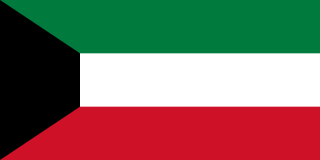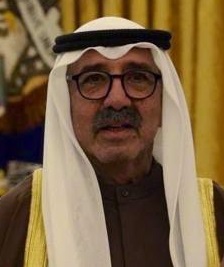
Culture of Kuwait describes the cultural aspects of the Kuwaiti society and is part of the Eastern Arabian culture. Kuwaiti popular culture, in the form of dialect poetry, film, theatre, radio and television soap opera, flourishes and is even exported to neighboring states. Within the Arab states of the Persian Gulf, the culture of Kuwait is the closest to the culture of Bahrain.

The Museum of Islamic Art (MIA) in Cairo, Egypt is considered one of the greatest museums in the world, with its exceptional collection of rare woodwork and plaster artefacts, as well as metal, ceramic, glass, crystal, and textile objects of all periods, from all over the Islamic world.

Kuwait, officially the State of Kuwait, is a country in West Asia. It is situated in the northern edge of Eastern Arabia at the tip of the Persian Gulf, bordering Iraq to the north and Saudi Arabia to the south. Kuwait also shares maritime borders with Iran. Kuwait has a coastal length of approximately 500 km (311 mi). Most of the country's population reside in the urban agglomeration of the capital and largest city Kuwait City. As of 2022, Kuwait has a population of 4.45 million people of which 1.45 million are Kuwaiti citizens while the remaining 3 million are foreign nationals from over 100 countries.

The women of Kuwait have experienced many progressive changes since the early 20th century. Since then, women have had increased access to education, gained political and economic rights, and financial power. They can serve in the police, military, and as judges in courts. However, women in Kuwait struggle against a patriarchal culture which discriminates against them in several fields. Kuwait's Bedoon (stateless) women are at risk of significant human rights abuses and persecution, Kuwait has the largest number of Bedoon in the entire region.
The Dream Dealer is a 2001 children's musical, with the book and lyrics by Marita Phillips and music by Harriet Petherick Bushman.
Mary Bruins Allison was one of the first American women to be trained in medicine in the United States to work as a missionary physician in Arabia. While attending medical college in Philadelphia, she learned Arabic. In 1934, she went to the Middle East to work as a missionary physician. In her forty-year long career, she worked primarily in Kuwait, as well as India, Qatar, Bahrain and Oman. In her capacity in Kuwait, she treated rich and poor women.

Charbel Dagher is a Lebanese professor at the University of Balamand, Koura, Lebanon. He has been an active and prominent voice on the Arab cultural scene, mainly in the fields of poetry, Arabic language, and Arab and Islamic arts. He is a Poet, writer and story-writer in both Arabic and French.
The following is a timeline of the history of Kuwait City, Al Asimah Governorate, Kuwait, and its metro surroundings.

Nuqat is a nonprofit organisation based in Kuwait that focuses on cultural development in the region. Diverse participants from all over the world join Nuqat throughout the year to discuss design, entrepreneurship, architecture, fine arts, technology, culture and every aspect of life that creativity permeates.
The Kuwaiti modern art movement emerged in the 1930s, Kuwait has the oldest modern arts movement in the Arabian Peninsula. Kuwait is home to more than 20 art galleries. In recent years, Kuwait's contemporary art scene has boomed. Kuwait has the second most lively gallery scene in the GCC.
The Sheikh Abdullah Al-Salem Cultural Centre is a cultural complex located in Kuwait City Kuwait, owned by the Amiri Diwan. It consists of six main components; The Natural History Museum, Science Museum, Space Museum, Arabic Islamic Science Museum, Fine Arts Centre and the external spaces known as the Public Realm. The Sheikh Abdullah Al-Salem Cultural Centre is a 18-hectare site making it the world's largest museum complex. The Sheikh Abdullah Al-Salem Cultural Centre was inaugurated in early 2018, it was the world's largest single-delivery museum project.

Arabic miniatures are small paintings on paper, usually book or manuscript illustrations but also sometimes separate artworks that occupy entire pages. The earliest example dates from around 690 AD, with a flourishing of the art from between 1000 and 1200 AD in the Abbasid caliphate. The art form went through several stages of evolution while witnessing the fall and rise of several Islamic caliphates. Arab miniaturists absorbed Chinese and Persian influences brought by the Mongol destructions, and at last, got totally assimilated and subsequently disappeared due to the Ottoman occupation of the Arab world. Nearly all forms of Islamic miniatures owe their existences to Arabic miniatures, as Arab patrons were the first to demand the production of illuminated manuscripts in the Caliphate, it wasn't until the 14th century that the artistic skill reached the non-Arab regions of the Caliphate.

Sheikh Nasser Sabah Al-Ahmad Al-Sabah was the First Deputy Prime Minister, Minister of Defense of Kuwait, and before that he was the head of the Amiri Diwan in 2006–2017. Nasser was the eldest son of the hereditary ruler or Emir of Kuwait, Sabah Al-Ahmad Al-Jaber Al-Sabah (1929–2020). Prior to his death in December 2020, just seventy-two days after his father's death, Nasser was identified as a leading candidate to become the Crown Prince of Kuwait, or the heir apparent. He was a key figure in Kuwait's Vision 2035 plan, which included a planned city in northern Kuwait dubbed "Silk City".
The Shah Jahan Diamond mined from Kollur, Golconda—(currently Hyderabad, India). It is a hololithic flat, table cut 56 carat diamond, used as an amulet—(Tawid'th). In late 1600 AD Mughal Emperor Jahangir gifted it to Prince Shah Jahan—(by his name it is known). Currently it is owned by Dar al Athar al Islamiyyah, Kuwait.

The Khalili Collection of the Hajj and the Arts of Pilgrimage is a private collection of around 5,000 items relating to the Hajj, the pilgrimage to the holy city of Mecca which is a religious duty in Islam. It is one of eight collections assembled, conserved, published and exhibited by the British-Iranian scholar, collector and philanthropist Nasser Khalili; each collection is considered among the most important in its field. The collection's 300 textiles include embroidered curtains from the Kaaba, the Station of Abraham, the Mosque of the Prophet Muhammad and other holy sites, as well as textiles that would have formed part of pilgrimage caravans from Egypt or Syria. It also has illuminated manuscripts depicting the practice and folklore of the Hajj as well as photographs, art pieces, and commemorative objects relating to the Hajj and the holy sites of Mecca and Medina.
Sheikha Bibi Duaij Al-Jaber Al-Sabah is a migration rights activist and curator from Kuwait. She founded the Social Work Society, which campaigns for the rights of migrant workers, and chairs Sadu House, a textiles museum and cultural centre dedicated to the woven art of Al Sadu.
Suʻād Māhir Muḥammad was an Egyptian archaeologist, best known for her work on the Islamic history of Egypt. She was awarded the Order of the Arab Republic of Egypt, second class, in 1977.

Lajvardina-type ceramics were developed in the 13th century following the Mongol invasion of Persia. It was produced throughout the Ilkhanate reign. It is characterized by its deep blue color and often features geometric patterns or foliage inlaid with gold leaf. The style was created using overglaze enamel. An initial layer of dark blue glaze, produced from cobalt, was applied, followed by another layer, often gold, on which the details were painted. It was primarily produced in Kashan, a center for ceramic production and lusterware in the 12th and early 13th centuries. The style was continuously used for tiles and ornamental objects from the 1260s C.E. until the mid-14th century, when production dropped significantly, coinciding with the fall of the Ilkhanate in 1335.











